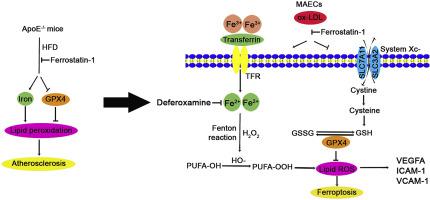Free Radical Biology and Medicine ( IF 7.1 ) Pub Date : 2020-08-05 , DOI: 10.1016/j.freeradbiomed.2020.07.026 Tao Bai 1 , Mingxing Li 1 , Yuanfeng Liu 1 , Zhentao Qiao 1 , Zhiwei Wang 1

|
Atherosclerosis (AS) is the fundamental pathological state of many serious vascular diseases, characterized by disorders of lipid metabolism. Ferroptosis is a type of regulated cell death that is mainly mediated by iron-dependent lipid peroxidation. In this study, whether ferroptosis has occurred in AS and the potential effects of ferroptosis on AS were investigated. Ferroptosis inhibitor ferrostatin-1 (Fer-1) was administered to high-fat diet (HFD)-induced AS in ApoE−/- mice. The results showed that Fer-1 could alleviate AS lesion in HFD-fed ApoE−/- mice. Additionally, Fer-1 partially inhibited the iron accumulation, lipid peroxidation and reversed the expressions of ferroptosis indicators SLC7A11 and glutathione peroxidase 4 (GPX4) in HFD-fed ApoE−/- mice. Next, we evaluated the effects of inhibition of ferroptosis on oxidized-low density lipoprotein (ox-LDL)-induced mouse aortic endothelial cells (MAECs). Results showed that Fer-1 increased cell viability and reduced cell death in ox-LDL-treated MAECs. Moreover, Fer-1 decreased iron content and lipid peroxidation and up-regulated the levels of SLC7A11 and GPX4. Additionally, Fer-1 down-regulated the expressions of adhesion molecules and up-regulated eNOS expression. Iron chelator deferoxamine was used to demonstrate ferroptosis could be partially inhibited by iron complexation in ox-LDL-treated MAECs. Our results indicated that ferroptosis might occur during the initiation and development of AS. More importantly, inhibition of ferroptosis could alleviate AS through attenuating lipid peroxidation and endothelial dysfunction in AECs. Our findings might contribute to a deeper understanding regarding the pathological process of AS and provide a therapeutic target for AS.
中文翻译:

抑制铁锈病通过减轻小鼠主动脉内皮细胞的脂质过氧化作用和内皮功能障碍来减轻动脉粥样硬化。
动脉粥样硬化(AS)是许多严重的血管疾病的基本病理状态,其特征是脂质代谢异常。Ferroptosis是一种受调节的细胞死亡类型,主要由铁依赖性脂质过氧化作用介导。在这项研究中,调查了是否在AS中发生过肥大症以及肥大症对AS的潜在影响。在ApoE -/-小鼠中,对高脂饮食(HFD)诱导的AS施用了肥大病抑制因子ferrostatin-1(Fer-1)。结果表明,Fer-1可以减轻HFD喂养的ApoE -/-小鼠的AS病变。此外,Fer-1在HFD喂养的ApoE -/-中部分抑制了铁的积累,脂质过氧化并逆转了肥大症指标SLC7A11和谷胱甘肽过氧化物酶4(GPX4)的表达。老鼠。接下来,我们评估了抑制铁锈病对氧化低密度脂蛋白(ox-LDL)诱导的小鼠主动脉内皮细胞(MAECs)的影响。结果表明,在经ox-LDL处理的MAEC中,Fer-1可提高细胞活力并减少细胞死亡。而且,Fer-1降低了铁含量和脂质过氧化作用,并上调了SLC7A11和GPX4的水平。另外,Fer-1下调粘附分子的表达并上调eNOS的表达。铁螯合剂去铁胺被用于证明在ox-LDL处理的MAEC中,铁的络合可以部分抑制铁的合成。我们的结果表明,肥大症可能在AS的发生和发展过程中发生。更重要的是,通过减弱AEC中的脂质过氧化作用和内皮功能障碍,抑制肥大症可以减轻AS。





















































 京公网安备 11010802027423号
京公网安备 11010802027423号